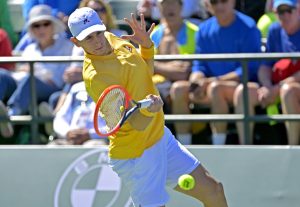Recently, some of the best women tennis players in the world have been affected by injury, illness and even life-altering disorders. The current World No.1, Simona Halep, withdrew from the season-ending WTA Tour Finals before they even began with a back injury, and far more worryingly the current World No.3, Caroline Wozniaki, who did compete in Singapore, announced that she had recently been diagnosed with rheumatoid arthritis. Obviously, injury and illness (even serious illness) are occupational hazards for athletes. Nevertheless, it is hard not to regard the recent spate of medical problems as being somehow emblematic of the current state of affairs at the top of women’s tennis. Put simply, no one woman is playing well enough or staying healthy for long enough to assert themselves as the dominant player in the game.
Ever since the WTA began producing computerized world rankings at the end of 1975, a total of 25 women have held the coveted No.1 singles ranking. Fascinatingly, for most of the time since 1975 it has been possible to identify a clear succession of No.1 players, in a way that is analogous to the mythical “lineal” World Heavyweight Boxing Championship, whereby one player rules the roost until they are defeated by the next dominant player.
Chris Evert was the first ever World No.1; she was overtaken at the end of the 1970s by Martina Navratilova, who largely dominated women’s tennis for the next decade; Martina gave way to Steffi Graf, who was the finest female player for most of the 1990s (although Monica Seles might well have rivaled her for that title if she had not been stabbed on court by an insane Steffi fan); a second Martina (Hingis) briefly replaced Graf, until she herself was swept away by the dual Williams sisters assault; and for most of the last 20 years one or other of the Williams sisters (first Venus, until she was struck down by the debilitating Sjögren’s syndrome, and then Serena) has been universally regarded as the greatest women’s tennis player in the world.
The situation now, at the end of the 2018 season, is not nearly so clear-cut. Serena, of course, is still trying to fight her way back to the top of the women’s game, or at least to the two further Majors that would take her clear of Margaret Court as the all-time winningest woman in tennis, after giving birth in such traumatic fashion at the end of 2017. However, although she is a fearsome, perhaps peerless competitor, even Serena is discovering just how hard it is for any woman (let alone one who is an athlete) to fully recover, both physically and mentally, from giving birth.
Although Serena made the finals of the last two Majors of the season, at Wimbledon and the US Open, she lost both of them in straight sets. Given that she is now 37, there must be question marks about whether she will ever regain the top spot (she is currently ranked only 15th in the world). Indeed, rather like Roger Federer, who is also 37, she may no longer even be primarily interested in returning to the No.1 spot, but instead might focus her remaining energy on simply winning Slams.
In the last couple of years, ever since Serena first began to focus on becoming a mother, there have been a succession of women’s World No.1s. In 2016, Angelique Kerber, who won both the Australian and US Open that year, briefly looked as if she might emerge as the next “uncontested No.1” (to use another phrase from boxing). However, in 2017 she slid back down the rankings and although she recovered sufficiently well this year to win Wimbledon she also admitted that she had not really enjoyed being at the top in 2016 as she felt the focus on her was too great. Well, in addition to all the physical and mental attributes that a No.1 (especially a dominant No.1) player requires, an ability to survive and even thrive in the spotlight is one of them.
Consequently, Kerber, for all the huge advances that she has made in her game in the last two or three seasons, is extremely unlikely ever to be the kind of truly great, multiple Major-winning champions that Chrissie, the Martinas and Serena were before her. And the fact that those former No.1s can be identified by their first names alone is itself a tribute to their standing, not only within tennis but within the wider world.
Currently, there is no outstanding candidate to become the next “lineal” world champion of women’s tennis. Indeed, the last few seasons have been characterized by players making sensational breakthroughs at Majors, even winning them, before subsequently returning to the pack, as it were, as they have struggled to build upon that initial astonishing success. Among the women who have followed this pattern are Garbiñe Muguruza, who won the French Open in 2016 and Wimbledon in 2017 but is currently ranked outside the world’s top 10; Jelena Ostapenko, who succeeded Muguruza as French Open champion in 2017 but is currently ranked outside the world’s top 20; and even Simona Halep, the current World No.1, who finally got the “Major” monkey off her back by winning the French Open this year but has done little since to suggest that she will win a number of Majors, or even a few, consecutively (which, of course, is another sign of a dominant player).
Of course, in one sense it will be wonderful if nobody emerges as the dominant player of the post-Serena era (we’re not there yet, but it can’t be far away, especially if she overtakes Margaret Court’s Major record). That would be a testament to the current competitiveness of the women’s game, in which no one woman is able to assert themselves over all the others. In another sense, however, every sport needs its truly great champions, those who are known even to non-sports fans, to set the standard for everyone else in the sport to aspire to. They force their rivals to improve simply to keep up with them and thus effectively raise the whole collective level of the sport, in the way that Evert, Navratilova, Graf, Hingis and the Williams sisters all did.
A personal suspicion (“hunch” would be more accurate) is that Naomi Osaka might just be the woman to break from the pack and finally replace Serena as unquestionably the greatest female player in the game. The principal reason is that, in addition to all her outstanding physical and technical attributes, she may just have the motivation – the insatiable hunger, as it were – to do it. That is because, to make one final comparison with boxing (the other great individual sport, which John McEnroe once described as tennis with gloves on), she might prove to be the female equivalent of Marvelous Marvin Hagler.
For those tennis fans who don’t know, Hagler was the undisputed middleweight boxing champion for most of the 1980s, which was the golden era for that weight division. Hagler defeated all-comers, including fellow legends such as Tommy Hearns and Roberto Duran, only finally losing his title in 1987 to “Sugar” Ray Leonard (a result that Hagler and many boxing writers still dispute to this day). Hagler always said that the reason he was able to remain at the top of his sport for so long was that he had been denied his initial “moment in the spotlight”. When he first won the middleweight crown in 1980, against Britain’s Alan Minter, he was unable to celebrate properly because a riot broke out in the arena and he had to dodge flying objects that were hurled at him by irate Minter fans.
Naomi Osaka may not have had to dodge missiles when she won the US Open in September, but she was still effectively denied her own “moment in the spotlight” by the antics of her opponent, Serena Williams, who chose to direct all her considerable fury at the umpire, Carlos Ramos, when he penalized her for being coached from the stands by Patrick Mouratoglou, rather than at Osaka. Consequently, just like Hagler back in London in 1980, Osaka was unable to celebrate the greatest moment of her life. As a result, she may just be driven on relentlessly, in a way that currently appears alien to the other women at the top of tennis, to win at least one more Major, so that she can truly celebrate it properly. And if she wins a second Major, she may just go on to win many, many more.






